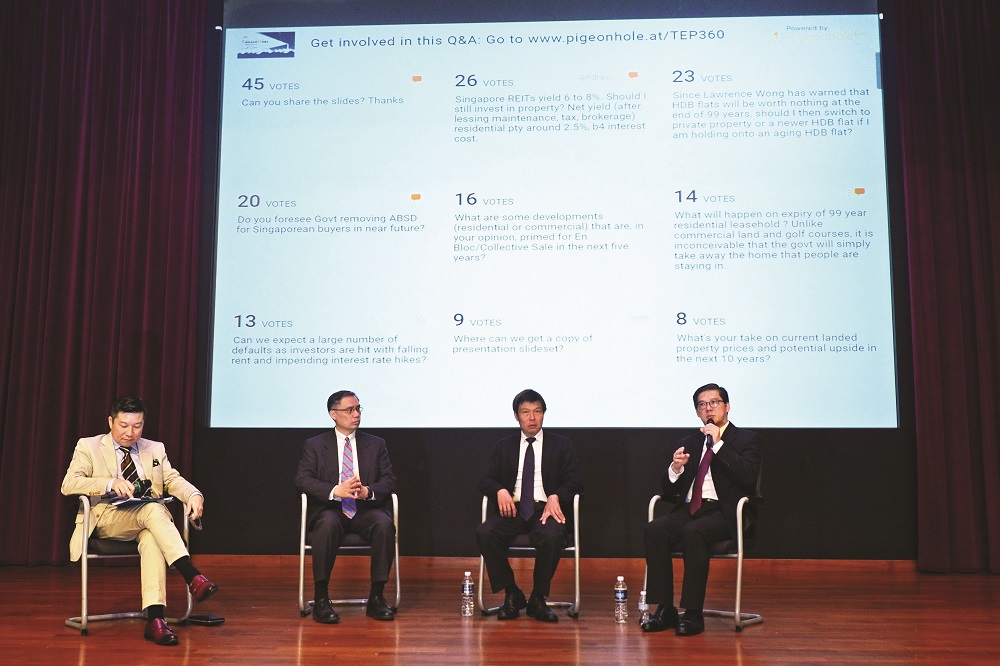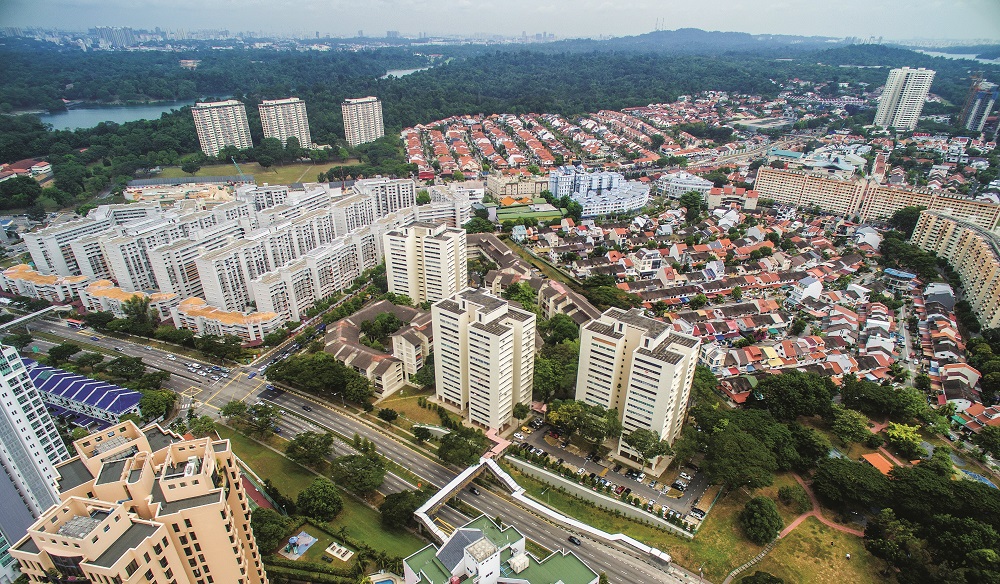
THE TEP360 seminar on April 8, entitled “Navigating through turbulent times”, was attended by about 350 participants. Of great interest to homeowners and investors is what opportunities are out there, given the current market uncertainty.
UOB senior economist Suan Teck Kin spoke on the state of Singapore’s economy. GDP grew 2% in 2016 and is forecast to grow by another 1.7% this year. He thinks the current growth rate of 2% to 3% — half of the 6% to 8% rate per annum that we have been used to over the past 40 years — will be the “new normal”.
Another concern is the retrenchment rate for last year, which was the highest since 2009. About 16,610 workers were let go in 2016 and the unemployment rate among Singaporeans and permanent residents was 3.2%, which is close to the 3.3% seen in 2009, says Suan.
“The unemployment rate will remain high for a while,” he reckons. “This is because of the transformation in the economy.” There are several issues affecting the economy: the ageing population, the disruption taking place across many sectors of the economy and the uncertainty owing to what is happening in other countries, such as Brexit in the UK, President Donald Trump’s policies in the US, the European political situation and the Chinese government’s policies.
Although the unemployment rate in Singapore has increased, it has not had a significant impact on debt levels. Currently, the debt service ratio, which is the amount of mortgage payment as a percentage of monthly income, stands at 25%. This is half the level seen during the Asian financial crisis in 1997/98 when the DSR was 50%.
“As long as interest rates do not return to the 7%-to-8% level last seen in the 1990s and unemployment does not rise above 5%, the DSR level should remain at a comfortable level, and the Singapore economy should be fine,” says Suan.
HDB as buffer
HDB has been an important buffer for the overall property market, as 80% of homeowners in Singapore live in public housing flats, according to Suan. “As long as the HDB market holds up and HDB resale prices are stable, that will provide a good support for private residential prices,” he says. “This is because the private housing market is supported by HDB upgraders’ demand.”
The concern of many attendees at the seminar was the statement by National Development Minister Lawrence Wong in a blog post on March 24 that homebuyers should not assume that all old HDB flats will be automatically eligible for the Selective En bloc Redevelopment Scheme (SERS). Wong also said that the leases for most HDB flats will eventually run out and the flats returned to HDB, which in turn will surrender the land to the state.
“The government is trying to rein in public expectations and minimise the escalation of HDB prices,” says Alan Cheong, Savills Singapore head of research and consultancy.
According to Cheong, the government’s concern could have been several million-dollar transactions of old HDB flats last year, such as the 1,571 sq ft executive flat on Lengkong Tiga that changed hands for S$935,000 in February 2016. The unit was completed in 1989. Another was a 1,561 sq ft executive flat at Block 101B Toa Payoh Lorong 2, which was completed 23 years ago and sold last June for S$980,000. In 2015, a 28-year-old executive apartment of 1,604 sq ft in Bishan fetched S$1.05 million.
Collective sales: Success not guaranteed
HUDC, or Housing and Urban Development Co, projects, which were developed in the 1970s and 1980s, have also been privatised. The gradually expiring leases in these developments are also a concern. “One of the key impetuses for owners of HUDC to take the collective sale route is to unlock the value of the development and let the private sector handle the renewal and maximise the untapped redevelopment potential that could be realised,” says Tan Hong Boon, JLL regional director of capital markets.
The most recent collective sale of an HUDC estate is Shunfu Ville, which was sold to Qingjian Realty for S$638 million last May. Each owner in the 358-unit development will walk away with S$1.78 million if the deal is successful. The site, located just 200m from the Marymount MRT station, can be redeveloped into a new project of more than 1,000 units, based on an average unit size of 1,000 sq ft. The Court of Appeal will be hearing the case on April 12, as two owners in the project object to the sale.

According to JLL’s Tan, who was involved in the collective sale of Shunfu Ville, the entire process took 30 months. “For investors looking to buy a unit in an ageing condominium or privatised HUDC estate in the hope of a collective sale, they have to be aware that it is a long-drawn-out process that could take anywhere from three to four years.”
The biggest collective sale site sold so far is still Farrer Court, a former HUDC estate with 618 units that sits on an 838,488 sq ft plot. Farrer Court was sold to a CapitaLand-led consortium in 2007 for a record S$1.34 billion. The new project, called d’Leedon, is a 1,715-unit condo development designed by the late Pritzker Prize winner, Zaha Hadid, and was completed in 2014.
The probability of a collective sale being successful is about 20%, says Tan. Over the past three years, there were only five successful collective sales. The number of failed collective sales over the same period was 20.
Inverse correlation between GLS sites and collective sales
Of the five collective sales that were completed recently, three — Shunfu Ville, Raintree Gardens and Harbour View Gardens — were done last year. Tan attributes the increase in the number of transactions to the fact that the number of sites offered for sale on the Confirmed List of the Government Land Sales (GLS) programme was just eight last year, while in 2015, it was just 12.
By contrast, from 2011 to 2014, the government released a record number of sites in the GLS programme. In 2011, it released 36 residential development sites on the Confirmed List; in 2012, 29 sites were launched; and in 2013, the figure was 23. In 2014, however, it tapered down to 17.
At the peak of the collective sale fever in 2005, 2006 and 2007, the number of sites sold en bloc to developers was 51, 78 and 88, respectively, says Tan. He attributes the spike in collective sale deals during those years to increased developer interest in prime district sites in anticipation of demand from the wealthy as a result of the two Integrated Resorts being built. The GLS sites were insufficient to satisfy demand then, adds Tan. “There’s an inverse correlation between the number of GLS sites and that of collective sales.”
The number of participants bidding for GLS sites recently — at least 12 bids were received — is an indication of pent-up demand by developers for sites, observes Tan.
Supply-led demand
In Singapore, demand is also supply-led. According to Savills’ Cheong, when many GLS sites are sold, new home sales also increase, and vice versa. He expects the government to release more GLS sites for tender, including the upcoming launch of Kampong Bugis under the new Master Developer plan, whereby 4,000 new residential units could be rolled out.
According to Cheong, the average length of a market down cycle from 1975 to 2011 was 8.4 quarters. The housing market has already seen 14 straight quarters of price declines. “The down cycle is overextended, possibly causing homebuyers’ impatience to buy,” he reckons.
The recalibration of the seller’s stamp duty on March 11 has also boosted sales at developers’ launches, including projects that were launched one or two years ago, Cheong points out. He believes the recalibration was a test conducted by the government to see how the market will react to changes made to the cooling measures.
His forecast is that prices of residential properties are set to increase this year, reversing the trend of the past 14 quarters. He expects prices of condos and apartments in the Core Central Region to rise about 3% a year in 2017 and 2018. Meanwhile, his projection is that prices of condos and apartments in the Rest of Central Region and Outside Central Region are likely to rise between 0% and 3% over the same period.
“As long as the unemployment rate stays low, the property market should be quite stable,” assures Cheong.
This article first appeared in The Edge Property Singapore, a pullout of The Edge Singapore, on April 17, 2017.
For more stories, download TheEdgeproperty.com pullout here for free.





